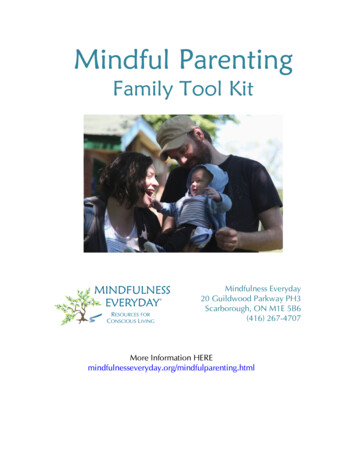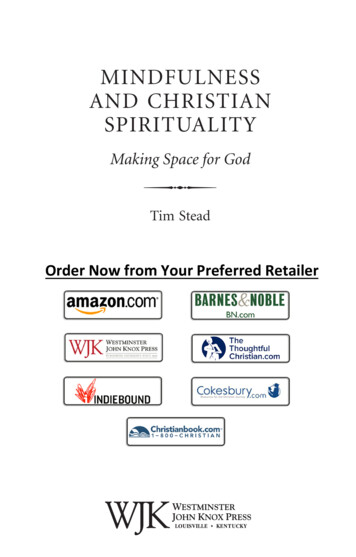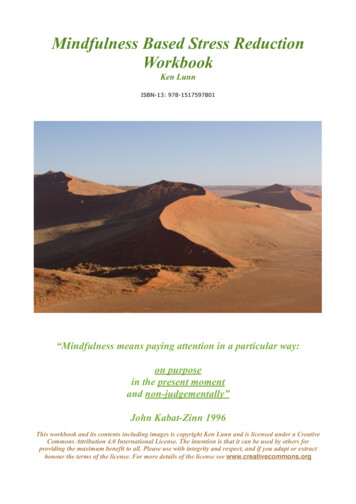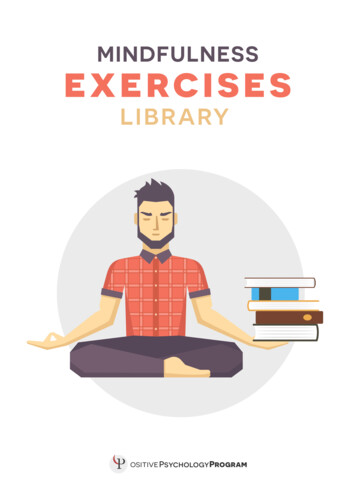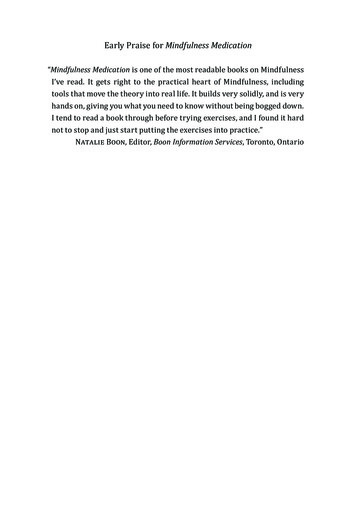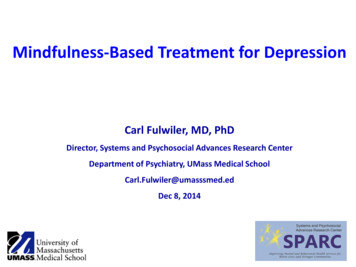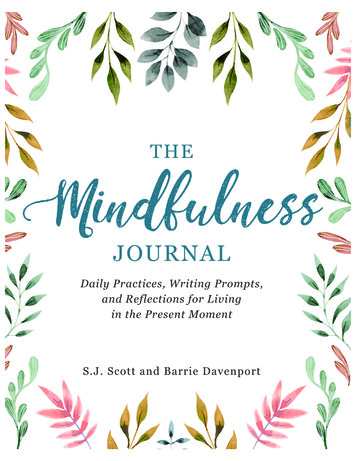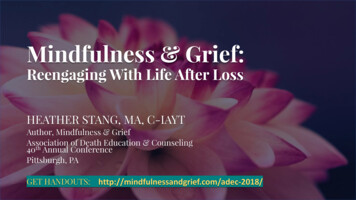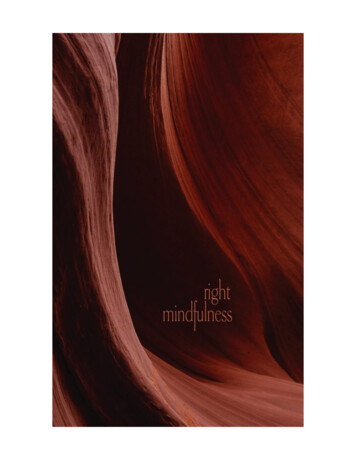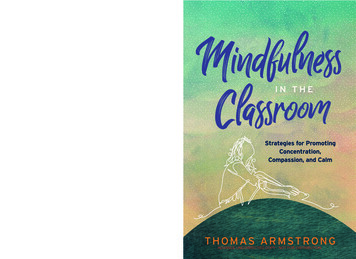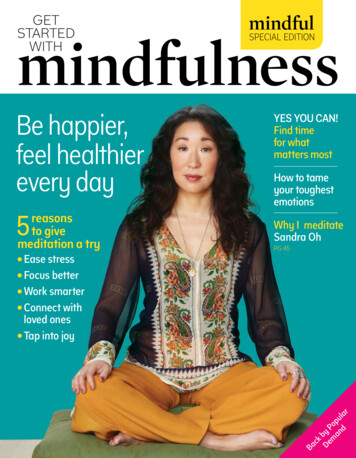
Transcription
GETSTARTEDWITHmindfulmindfulnessBe happier,feel healthierevery day5reasonsto givemeditation a try Ease stressSPECIAL EDITIONYES YOU CAN!Find timefor whatmatters mostHow to tameyour toughestemotionsWhy I meditate Sandra OhPG 45 Focus better Work smarter Connect withBackDe by Pm opan ud larloved ones Tap into joy
PRESENTSGET STARTEDWITH MINDFULNESSWelcome tomindfulnessA NEW video course taught by Elaine SmooklerOfor a limited timeSAVE70%Diminish the stress in your life Sharpen your concentrationand focus Free yourself from negative thoughts Connect moredeeply with others Experience the tranquility already within youmindful.org/mindfulcourse70n behalf of Mindful magazineand mindful.org, I’m happy to welcomeyou to Get Started with Mindfulness.We’ve created this guide to helpyou learn what mindfulness is, howit can benefit you, and how to beginpracticing it in your everyday life.Why give mindfulness a try?Because it’s a simple, accessible wayto live a richer and happier life. It canbring better performance at work andat play, more harmony in personalrelationships, and improved health.Mindfulness does these thingsby bringing you back in touch withyourself, with your loved ones, with thepeople you encounter each day, andwith the lovely world surrounding you.Cultivating your mindfulness is arewarding, lifelong journey. The wayto start is by taking a few simple steps.In this case, you only need to turnthe page!IN THESE PAGES,YOU’LL FIND: Expert advice and instruction from topmindfulness teachers Answers to the common questions that come upwhen you’re new to meditation Encouragement from other meditators and storiesabout how mindfulness has made their lives better Try-it-now techniques for using mindfulness atwork, at home, in traffic, at mealtimes,and more Resources for taking mindfulnesspractice further.If you like what you find here, and want to knowmore, please visit us at mindful.org or write to usat mindful@mindful.org.Barry BoyceEditor-in-ChiefMindful magazine & mindful.orgmindful.org 3
The Foundation for a Mindful SocietySpecial EditionEditorKatherine GriffinArt DirectorCharli OrnettMindfulEditor-in-ChiefBarry BoyceArt DirectorJessica von HandorfDeputy EditorClaire Ciel ZimmermanAssociate Art DirectorSpencer CreelmanEditor, DigitalHeather HurlockDeputy Editor, DigitalStephany TlalkaEditors-at-LargeKaitlin QuistgaardHugh DelehantyAssociate Editor, DigitalNicole Bayes-FlemingEditorial AssistantAmber TuckerGeneral ManagerJohn SheehyConsumer Marketing DirectorDaniel ScottCirculation Planning DirectorCatherine FlynnAudience DevelopmentManagerLeslie Duncan-ChildsFulfillment ManagerRebecca PearsonContributing EditorsKelle WalshKatherine GriffinTeo FurtadoBarbara GrahamInterim Business Development& Partnerships DirectorBakes Mitchellkevin@mindful.orgJames Gimian, Executive DirectorChris McKenna, Mindfulness in EducationProgram ManagerBoard members: James Gimian,Michael Chender, Susan Kaiser Greenland,Larry Horwitz, Andy Karr (acting chair),Jim Rosen, Dinabandhu Sarley228 Park Avenue S #91043New York, NY 10003-1502 USATo make a donation to the foundation,please visit mindful.org/donateEditorial & Central Business Office5765 May StreetHalifax, Nova Scotia, B3K 1R6 Canadamindful@mindful.orgCustomer ServiceSubscriptions: Toll free: 1-855-492-1675subscriptions@mindful.orgRetail inquiries: 732-946-0112Human Resources ManagerCindy LittlefairGraphic DesignerChristel LeBlancAdministrative AssistantSarah CreelmanChelsea ArsenaultAdvertising Sales Coordinatorchelsea@mindful.orgNancy DenglerAdvertising Sales Manager215-622-3092nancy@mindful.orgWe wish to thank the 1440 Foundation for their enduring andsustaining support, and the Hemera Foundation for their visionarypartnership in our founding years.4 get started with mindfulnessMindful is published by the Foundation for aMindful Society. The Foundation’s mission isto support mindfulness champions to increasehealth, well-being, kindness, and compassionin society.ControllerKenneth SwickAdvertising InquiriesKevin GillespieAdvertising DirectorHealthy Mind, Healthy LifeDiscover expert advice & helpful practicesfor living a mindful life.Don’t miss the next great issue of Mindful magazine.Subscribe Todaymindful.org
dfulnessa habitstickwith itWHY MEDITATE?HOW TO MEDITATEBRING IT INTO YOUR LIFEDEEPEN YOUR PRACTICEIt will change your life 10Meditation 101 30Sow the seeds of mindfulness 56Going the distance 112What is mindfulness, anyway? 12Debunking the myths 145 simple reasons to try meditation 15Deepen concentration and compassion 16Does why you meditate matter? 24Sitting meditation essentials 325 practices to refresh your day 58Posture: 6 steps to being upright 334 simple steps for finding balance 64Props for every body 34Friends help you see what you can’t 65Am I doing this right? 36AT WORKThe joy of mindfulness: Sandra Oh 45Bust stress 66Mindful movement basics 463 ways to detoxify conflicts 67Walking meditation 6 ways 485 practices for buildingemotional intelligence 6810 yoga poses for meditators 50Relax into a body scan 52Be smarter than your phone 69Are you addicted to doing? 70Set boundaries in your virtual office 78Learn to say “no” 80Watch what you’re typing 82IN RELATIONSHIPSAsk the experts 114Stay with meditation.and enjoy it 116How to find a teacher 122Why meditation friends can help 123Choosing the right program 1247 talks to inspire you 125126 CONTRIBUTORS128 PARTING THOUGHTON THE COVERActor and longtimemeditator Sandra Oh.Photograph by LeverRukhinMake the connection 846 get started with mindfulnessChoose to be present 88Anger, jealousy, fear:Tame your toughest emotions 905 steps to a more mindful home life 98Phone etiquette you’ll love 99SELF-CAREAILA IMAGES/STOCKSYFROM LEFT: SHELLY PERRY/STOCKSY, JOSHUA SIMPSONAre you listening? 86Want to be happy and healthy?Make friends with yourself 1005 steps to fresher mornings 102Rediscover the joy of play 104Snack like you mean it 106A bedtime ritual for better sleep 108mindful.org 7
Before you begin TK KEY WORDbeforeyoubeginRONNIE COMEAU/STOCKYwhymeditate?mindful.org 9
Before you begin CHANGES AHEADMind shiftMeditation will change your life in subtle ways, like ripples thatalter the surface of water. Expect the unexpected.10 get started with mindfulnessVERSTA/SHUTTERSTOCKART CREDITIf you tell an experienced meditator thatyou’re considering taking up the practice, one response you may hear is, “It willchange your life.”That’s true—changes are pretty much guaranteed. But it’s hard to predict justwhat kind of changes you’re likely to experience.You’ve no doubt heard about the many benefits of meditation. In this section,longtime teacher Sharon Salzberg explains how it can deepen the qualities ofconcentration, mindfulness, and compassion that we already have within us.But the truth is, the benefits will be a little different for each person. As you’lldiscover in “Does why you meditate matter?” (page 24), a lot depends on you—who you are, what your life is like, and what draws you to meditation practice.In the beginning, you may simply notice small quiet shifts in your awareness.You may find that your everyday life feels more spacious. And within that newspace, you might start to notice possibilities that you weren’t aware of before.Your life may open up in ways that surprise you.Beginning a meditation practice can be like tossing a stone into a pond, orlike raindrops falling into water. You’ll see ripples moving over the surface of thewater; at first, you don’t know exactly what shape those ripples will take or howfar they will reach. But you can be sure that the ripples will be there. They willfollow a unique pattern created by the person you are in your life right now, andby the particular way that you practice.mindful.org 11
Before youBeforebegin you MINDFULNESSbegin TK KEYDEFINEDWORDWhat ismindfulness?12 get started with mindfulnessMindfulness is the basic humanability to be fully present, aware ofwhere we are and what we’re doing,and not overly reactive to or overwhelmed by what’s going on around us.While mindfulness is innate, it canbe cultivated through proven techniques, particularly sitting, walking,standing, and moving meditation; shortpauses we insert into everyday life; andmerging meditation practice with otheractivities, such as yoga or sports.When we meditate it doesn’t helpto fixate on the benefits, but rather tojust do the practice, and yet there arebenefits or no one would do it. Whenwe’re mindful, we reduce stress,perform better, gain insight throughobserving our own mind, and increaseour attention to others’ well-being.Mindfulness meditation allows usto suspend judgment and unleash ournatural curiosity about the workingsof the mind, approaching our experience with warmth and kindness, toourselves and others. But don’t takeour word for it—try it for yourself.ART CREDITMindfulness. It’s a pretty straightforward word. It suggests that the mindis fully attending to what’s happening,to what you’re doing, to the spaceyou’re moving through. That mightseem trivial, except for the annoyingfact that we so often veer from thematter at hand. Our mind takes flight,we lose touch with the body, and prettysoon we’re engrossed in obsessivethoughts about something that justhappened or fretting about the future.And that makes us anxious.Yet no matter how far we drift away,mindfulness is right there to snap usback to where we are and what we’redoing and feeling.If you want to know what mindfulness is, it’s best to try it for a while.Since it’s hard to nail down in words,you will find slight variations in themeaning in books, websites, audio, andvideo. Here’s an all-purpose definitionthat treats mindfulness as a quality thatevery human being already possesses,rather than something we have toconjure up.ROB AND JULIA CAMPBELL/STOCKSYThe word seems to be everywhere these days. Just what,exactly, are people talking about?mindful.org 13
Before you begin MYTHS & FACTSDebunkingthe myths ofmindfulnessNothing could be farther from the truth.Far from being an escape, mindfulness takesyou right into the heart of reality, where you getto see how your thoughts shape your perceptionsof what you experience, how the activities inyour mind cause yourself and others pain andsuffering, and what motivates you to do whatyou do. It’s not an escape, or even a vacation.It’s a journey within, which helps you seereality better—to more readily distinguishwhat’s real from whatyou fabricate.It’s selfishIt’s only forlaid-back peopleHere we go again—another completemisconception. Everyone, no matterwhat their lifestyle is, needs time torecharge and regroup and reflect.Mindfulness practice is one of thebest ways to give your mind a truerest—and emerge refreshed totake on new challenges.You loseyour edgeIt’s true that meditation practice,even when you do it in a group, is timealone, but it’s not selfish. The relaxationand clarity that come with mindfulnesspractice can help you to listen better, paymore attention to the needs of others,and be present with your loved oneswith less distraction. Yourmindfulness can be a gift toothers in your life.The myth here is that meditationinvolves a fuzzy state of mind, likesleeping while you’re still awake. Butpracticing mindfulness is not about zoningout. You train yourself to pay closerattention than usual and become morefocused throughout your life.Meditating can actually help youto get into “the zone” andstay there longer.Understandyour painLowerstressConnectbetterImprovefocusMental pain andanxiety are abackground noisethat can underliemuch of whatwe do. Here’s achance to seefirsthand what’scausing it.There’s lots ofevidence thesedays that excessstress causesmany illnessesand makes otherillnesses worse.Mindfulnessdecreases stress.Ever find yourselfstaring blanklyat a friend, lover,child, and you’veno idea whatthey’re saying?Mindfulnesshelps you givethem your fullattention.It can befrustrating tohave our mindstray off whatwe’re doingand be pulledin six directions.Meditation honesour innate abilityto focus.ReducebrainchatterThe nattering,chattering voicein our headseems neverto leave us alone.Isn’t it time wegave it a littlebreak?We’re told to ‘just be in the present moment,’ but how do we do that?Mindfulness is a tool, a technique, that teaches us how to actually do it.”Diana Winston, Director of Mindfulness Education, UCLA Mindful Awareness Research CenterJASON LEEMeditation does not involve ending thethought process. It isn’t about trying toachieve a particular state of mind. It is simplytaking the time to become familiar with howyour thought process actually works, sinceyou have the best vantage point to view what’sgoing on in your own mind. Once you seethat, you don’t stop thoughts, but theymight not control you quiteso much.It’s all too easy to come upwith excuses for why we can’tmeditate, but there are lotsof excellent reasons to do it.Here are just a few.1 2 3 4 5It’s anescape from realityIt’s aboutstopping thoughts14 get started with mindfulness5 goodreasons tomeditateSome of the popular images and ideas surrounding mindfulness are just plain wrong. When youbegin to practice it, you may find the experiencequite different from what you expected. There’sa good chance you’ll be pleasantly surprised.mindful.org 15
Before you begin FINDING YOUR WAYMeditation:Yes you canPracticing meditation doesn’t involvea whole new set of skills. The reasonit works so well is because it enhancesthe life skills we already have.By Sharon Salzberg16 get started with mindfulnessILLUSTRATIONS BY ADRIAN JOHNSONART CREDITART CREDITThe most common responseI hear these days when I tell someone I teach meditation is:“I’m so stressed out. I could really use some of that.” I amalso amused to hear fairly often, “My friend should reallymeet you!” I’m happy to see that meditation is known moreand more as something that could be directly helpful in ourday-to-day lives. Anywhere stress plays a role in our problems, meditation can have a potential role in its relief.Meditation practice need not be tied to any belief system.The only necessary belief is not a dogmatic one, but one thatsays each of us has the capacity to understand ourselves morefully, and to care more deeply both for ourselves and forothers. Its methods work to free us of habitual reactions thatcause us great unhappiness, such as harsh self-judgment,and to develop wisdom and love. Meditation gives anybodywho pursues it an opportunity to look within for a sense ofabundance, depth, and connection to life.Rather than an ornate, arcane set of instructions, basicmeditation consists of practical tools to deepen three corequalities: concentration, mindfulness, and compassion. mindful.org 17
Before you begin FINDING YOUR WAY1ConcentrationConcentration is theart of gathering all thatenergy, that stormy,scattered attention, andsettling, centering.18 get started with mindfulnessConcentration steadies andfocuses our attention so thatwe can let go of unhealthy innerdistractions—regrets about the past,worries about the future, addictions—and keep from being seducedby outer ones. Distraction wastesour energy, but concentrationrestores it.We often experience our attentionscattering to the four winds. We sitdown to think something through orwork through a dilemma, and beforewe know it, we’re gone. We’re lostin thoughts of the past, often aboutsomething we now regret: “I shouldhave said that more skillfully.”“I should have been less timid andspoken up.” “I should have beenwiser and shut up.” We aren’tthinking things through to finda means to make amends. Instead,we’re just lost.Or our distractedness propels usinto anxiety-filled projections aboutthe future. Imagine you are sittingin an airplane at one of the NewYork City airports. Suddenly youstart thinking, “Oh no, I think thisplane might leave late. I’m sure itwill be late. Now I’m going to missmy connection. What will thatmean? That means I’m going toarrive in Portland, Oregon, aftermidnight. There won’t be any cabs!What’s going to happen to me?” It’sas though Portland were famousfor having people vanish if they landafter midnight!Without concentration, our mindsspin off into the future in a way thatisn’t like skillful planning but morelike exhausting rumination. WhenI see my own mind beginning thatarc of anxiety, I have a saying Iuse to help restore me to balance:“Something will happen.” Therewill be a bus. I’ll spend the night inthe airport. Something will happen.I can’t figure it all out right now.Concentration is the art ofgathering all of that energy, thatstormy, scattered attention, andsettling, centering. Someone cameup to talk to me recently when Iwas teaching, protesting my use ofthe word concentration. He said itreminded him of repression, as if hewere squeezing his attention ontosomething, resisting and resentinganything else that came up to pullhis attention away. I asked him ifsteadying or settling would be goodreplacements; he happily acceptedthem. That’s what concentrationactually means. It’s not a forced,tense, strained effort. It’s lettingthings settle on what is at hand.PRACTICESharpen your focusTry this 5-minute exercise toexplore the power of a focusedmind.Take a relaxed seated position. Locatesomething in your field of vision andstart putting your focus on it. Asthoughts carry you away—includingthoughts about the object itself—return to placing your bare attentionon it. Now, let your gaze be looser.Still take in the object but also a littlemore of what’s around it. Then tightenyour focus on the object again. Noticethe power you have to choose whatto center your attention on.mindful.org 19
Before you begin FINDING YOUR WAY2MindfulnessMindfulness refinesour attention so that we canconnect more fully and directlywith whatever life brings. Somany times our perception ofwhat is happening is distortedby bias, habits, fears, or desires.Mindfulness helps us seethrough these and be muchmore aware of what actually is.20 get started with mindfulnessImagine you’re on your way to aparty when you run into a friendwho mentions an earlier meetinghe had with your new colleague.He says, “That person is so boring!”Once at the party, who do you findyourself stuck talking to but thatnew colleague! Because of yourfriend’s comment (not even yourown perception), you end up notreally listening carefully to themor looking fully at them. More likelyyou are thinking about the next 15emails you need to send or frettingas you gaze about the room andsee so many people you’d rather betalking to. Everything this personis saying increases your ire andfrustration.But if you realize what’s going on,it might be that you drop the filterof your friend’s comment anddetermine to find out for yourself,from your own direct experience,what you think of your new colleague. You listen, you observe, youare open-minded, interested. By theend of the evening you might decide,“I concur. I find that person reallyboring.” But perhaps not; life alsoprovides many surprises. What’simportant is that we’re not merelyguided by what we’ve been told,by the beliefs of others, by dogmaor prejudice or assumption. Instead,we shape our impression with asclear and open a perception aspossible.Mindfulness does not dependon what is happening, but is abouthow we relate to what is happening.That’s why we say that mindfulnesscan go anywhere. We can bemindful of joy and sorrow, pleasureand pain, beautiful music and ascreech. Mindfulness doesn’t meanthese all flatten out and becomeone big blob, without distinction orintensity or flavor or texture. Rather,it means that old habitual ways ofrelating—perhaps holding on fiercelyto pleasure, so that, ironically, weare actually enjoying it less; orresenting and pushing away pain, sothat, sadly, we suffer a lot more; ornumbing out, disconnecting fromordinary, not-very-exciting experiences, so that we’re half in a dream alot of the time. All of these limiting,self-defeating reactions don’t haveto be there.We can easily misunderstandmindfulness and think of it aspassive, complacent, even a bit dull.I was teaching somewhere recentlyand began the formal meditationinstruction, as I often do, with thesuggestion to simply sit in a relaxedway and listen to the sounds in theroom. Someone raised his hand rightaway and asked, “If I hear the soundof the smoke alarm, should I justsit here ‘mindfully,’ knowing I’mhearing the smoke alarm go off,or should I get up and leave?” Iresponded, “I’d ‘mindfully’ get upand leave!”I understood his question. Whenwe hear phrases commonly usedto describe mindfulness, like “justbe with what is,” “accept the presentmoment,” “don’t get lost in judgment,” it can sound pretty inert.But the actual experience ofmindfulness is of vibrant, alive,open space where creative responsesto situations have room to arise,precisely because we’re not stuck inthe well-worn grooves of the sameold habitual reactions. In mindfulness, we don’t lose discernmentand intelligence. These qualities,in fact, become more acute as stalepreconceptions and automatic, rigidresponses no longer rule the day.Mindfulness does notdepend on what ishappening, but isabout how we relateto what is happening.mindful.org 21
Before you begin FINDING YOUR WAY3CompassionCompassion opens ourattention and makes it moreinclusive, transforming theway we view ourselvesand the world. Instead ofbeing so caught up in theconstructs of “self” and“other” and “us” and “them”that we tend to see the worldthrough, we see things muchmore in terms of connectionto all. This fundamentaltransformation fromalienation begins withmore kindnessto ourselves.22 get started with mindfulnessEven in techniques that don’tparticularly emphasize kindnessor compassion, these qualitiesare inevitably being developed inmeditation. If we go back and look atthe foundational exercise I described,developing concentration, we findthat it is often done by choosing anobject such as the feeling of thein-and-out breath, then settling ourattention on it. What we discover atfirst, sometimes to our shock, is thatit usually isn’t 800 breaths beforeour minds wander. More commonly,it is one breath, maybe two or three,then we are lost. Maybe very lost ina fantasy or memory.Then comes the moment we realizewe’ve been distracted. Our commonresponse is to feel that we’ve failed,to rail against ourselves. What wepractice, though, is letting go gentlyrather than harshly and returning tothe breath or object of concentrationwith kindness and compassion forourselves. Thus, the qualities ofcompassion and kindness deepen evenif we don’t give voice to those words.And what we do for ourselves, wecan also begin to do toward others.A few years ago I was on my way toTucson, but my plans were challengedwhen I found myself in an airplanesitting on a runway for four-and-ahalf hours at La Guardia Airport.Looking back on it, I sometimesrefer jokingly to those hours as “thebreakdown of civilization.” It was hot,and got hotter. After a point, peoplestarting yelling, “Let me off thisplane!” The pilot resorted to gettingon the PA system and saying sternly,“No one is getting off this plane.”I wasn’t feeling all that chippermyself. I couldn’t get in touch with thepeople in Tucson who were supposedto pick me up at the airport, and IIf we can see thegood withinourselves, kindnessbegins to flow.was concerned about them. I had anapartment to go to in New York Cityand kept thinking, to no avail, “Ican just go back there and try againtomorrow.” I was hot. I felt pummeledby the people shouting around me.Then I recalled an image that agood friend of mine, Bob Thurman,author of Infinite Life: Seven Virtuesfor Living Well, uses to describe theflow of kindness and compassion thatcomes from seeing the world moretruthfully. He says, “Imagine you areon the New York City subway, andthese Martians come and zap thesubway car so that those of you in thecar are going to be together forever.”What do we do? Well, if someoneis hungry, we feed them. And ifsomeone is freaking out, we try tocalm them down. We might not likeeverybody or approve of them, but weare going to be together forever. Sowe need to respond with the wisdomof how interrelated our lives are—andwill remain.Sitting on that airplane, I recalledmy friend’s story. I looked aroundthe cabin and thought, “Maybe theseare my people.” I saw my worldviewshift from “me” and “them” to “we.”The claustrophobia eased.In terms of meditative understanding (in contrast to our usualway of thinking, which might regardthese qualities as gifts we can donothing to cultivate or as immediateemotional reactions we enjoy butcan’t stabilize), kindness andcompassion are indeed skills wedevelop. Not in the sense of forcingourselves to feel, or pretend to feel,an emotion that is not there. Instead,if we learn to pay attention in adifferent, more open way—seeingthe good within ourselves insteadof fixating on what we don’t like,noticing those we usually ignore,letting go of categories and assumptions when we relate to others—we are creating the conditions forkindness and compassion to flow.We practice meditation in the endnot to become great meditators butto have a different life. As we deepenthe skills of concentration, mindfulness, and compassion, we find we haveless stress, more fulfillment, moreinsight, and vastly more happiness.We transform our lives. mindful.org 23
Before you begin SET AN INTENTIONDoes why youmeditate matter?Don’t let meditation become just one more thing on your to-dolist. Reflecting on your intention gives you a reason tocontinue—and brings life, energy, and direction to your practice.By Shauna ShapiroOSebeneSelassie,meditationteacherand formerexecutivedirectorof the NewYork InsightMeditationCenterften when we begin a meditationpractice, the focus is on the how: How do I practice? What are the instructions?The why is often passed over. But knowing the why behind what we are doing isjust as important as understanding the how.Traditionally, the study of meditation begins with explicit reflection on one’sintention and motivation for beginning a practice. The process of deeply examiningand developing our intentions can transform the practice, giving it life, energy, anddirection. As Jon Kabat-Zinn, the founder of Mindfulness-Based Stress Reduction,puts it, “Your intentions set the stage for what is possible. They remind you momentto moment of why you are practicing I used to think meditation practice was sopowerful that as long as you did it at all, you would see growth and change. Buttime has taught me that some kind of personal vision is also necessary.”JOSHUA SIMPSONIntention helps motivate you24 get started with mindfulnessOur intention creates the context and motivation that fuels our desire to practicemeditation. It supports us in facing the anxieties, confusions, and doubts thatoften accompany meditation. We remind ourselves why we are practicing, andthis gives us the courage, desire, and energy to continue.Intention is not a static, fixed quality, but a continually evolving exploration.The insights gained during practice inform our intentions, and these newintentions bring new motivation and clarity to our practice. As a clinical psychologist who uses meditation in my practice, when I begin work with my clients, Ialways ask, “Why are you here? Why do you want to learn to meditate?” This is amindful.org 25
Before you begin SET AN INTENTIONquestion we return to again and again, because the clients’ intentions change as a result of what they discover through therapy.For example, one of my patients, a divorced father with a youngson, began meditating to decrease his anxiety and panic attacks. Hisintention was clear: “I hope this practice will reduce my anxiety.”Before sitting, he reminded himself: “I’m practicing so I can becomeless anxious.” As he continued to practice for some months, henoticed his relationship to anxiety beginning to shift.Intention supports usHe still felt the sensations in his body of fear, tension,and worry. He still noticed the anxiety about the future,in facing many of theand yet he was able to see all this clearly, with someobjectivity and, in certain moments, even equanimity.challenges of meditation,As his practice continued, he began to see the way hismind reacted and created stories. He realized the manysuch as anxiety,ways he experienced suffering and contributed to thesuffering of others due to these unexamined reflexiveconfusion, and doubt.processes of mind. In one session, out of the blue, awellspring of compassion arose for his six-year-old son. He sawhow confused and afraid his son felt because of his parents’ divorceand understood the origin of his son’s acting out. My patient realizedmeditation was helping him become a better father, and his motivation to practice deepened. His intention expanded to includebecoming a more compassionate father.Note, though, that intention is not about starting a treadmill ofself-improvement. Our intention is simply a guide, connecting uswith what we most cherish and reminding us of the direction wewant to take. We must be careful to not make meditation practiceone more way to beat ourselves up when we do not meet our “goals.”PRACTICEConnect withyour vision1 2 3 426 get started with mindfulnessART CREDITOnce an intention is set, let it goPaulo Coelho uses an apt metaphor: shooting an arrow. “The arrowis a projection of the intention into space.” Once it’s shot, the archercan do nothing but observe the arrow’s flight with ease and calm,then let it go. Once an intention is set, we can let it go and rest intothe practice itself. Intention will carry us as we travel the vast spacein meditation practice between here and there.Our intention connects us to what is of greatest value and importance in our life. It can also help connect us to something larger thanourselves, expanding beyond our personal desires and recognizing thepossibili
mindfulness teachers Answers to the common questions that come up when you’re new to meditation Encouragement from other meditators and stories about how mindfulness has made their lives better Try-it-now techniques for using mindfulness at work, at home, in traffic, at mealtimes, and more Resources
